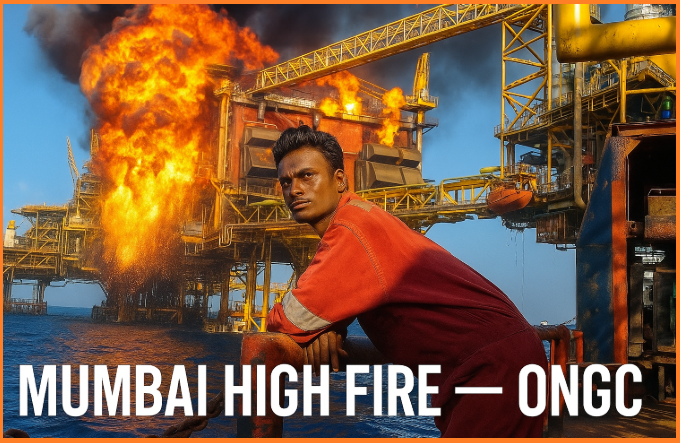On July 27, 2005, a catastrophic fire engulfed the Mumbai High North (BHN) offshore installation, part of ONGC’s Mumbai High field located roughly 160 km off the Mumbai coast. The blaze resulted from a collision between a support vessel (Samudra Suraksha) and export risers, triggering a powerful jet fire that swiftly destroyed the platform within two hours (Wikipedia).
Contents
Casualties & Evacuation
- The complex harbored approximately 384 personnel; although around 362 were rescued, 22 lives were lost—11 bodies recovered and 11 remains missing (Wikipedia).
- Official figures at the time reported 3 confirmed deaths, with 45 missing in initial press statements (The Tribune).
Root Causes & Contributing Factors
- A medical evacuation operation went awry: the vessel approached using a faulty dynamic positioning system amid monsoon seas with strong winds and currents; this led to the vessel striking and severing gas export risers outside the platform structure design envelope (Wikipedia).
- The risers lacked fire protection, violating critical safety design principles and leaving them vulnerable to cascading failure during flare-up (Wikipedia).
- The event highlighted poor planning around marine vessel management, evacuation planning, and maintenance of a secure exclusion zone around offshore installations (Wikipedia).
Operational Impact & Losses
- The BHN complex handled a significant share of Mumbai High’s output—approximately 110,000 barrels per day, representing nearly 15–18% of India’s domestic oil production and about 180,000 bpd capacity in the North complex (Wikipedia).
- Production was suspended; ONGC lost that output and had to redirect flows to neighboring platforms to partially offset the shortfall. The estimated daily loss stood at 120,000 barrels of oil and 4.4 million cubic meters of gas (The Indian Express).
- Total damage was estimated at US $370 million or over ₹1,700 crore (including insurance payouts) (Wikipedia, Rediff, The Economic Times).
Rescue Response & Safety Measures
- A vast rescue operation involving ONGC personnel, Indian Navy, Coast Guard, supply vessels, and ships including Samudra Prabha helped evacuate survivors and combat the fire. Some crew members jumped into the sea for survival (Wikipedia).
- Only two of eight lifeboats and one liferaft deployed. Several divers trapped in saturation chambers were rescued 36 hours later after systems cooled down (Wikipedia).
- Samudra Suraksha drifted and sank four days post-incident near Mumbai’s coast (Wikipedia).
Aftermath: Rebuilding & Policy Changes
New Platform & Production Restoration
- ONGC commissioned a new platform and processing complex in 2012, at a cost of ₹6,060 crore, replacing the previous BHN facility. The new setup boosted output capacity by around 9,000 bpd, pushing overall Mumbai High production to approximately 206,000 barrels per day. The recovery factor is projected to rise from 24% to 40% by 2030, producing nearly 55 million tonnes of oil and 6.5 billion cubic meters of gas by then (The Indian Express).
Insurance Payout
- ONGC received a final insurance settlement of ₹864 crore, contributing to a total payout of about ₹1,700 crore from insurance companies for loss recovery (Rediff).
Safety Reforms
- The disaster prompted major regulatory reforms. India enhanced oversight through the Oil Industry Safety Directorate (OISD), mandating stricter offshore safety practices, including structural risk assessments, risers protection, and exclusion zone enforcement (Wikipedia).
Lessons Learned
- Engineering design standards must protect critical infrastructure like risers, especially in collision-prone offshore zones.
- Marine operational protocols must include contingency handling for emergency procedures, especially in harsh weather.
- Adequate fire mitigation systems and passive protection measures are essential for offshore installations.
- Emergency planning and evacuation drills must ensure effective deployment and functioning of survival equipment.
The July 27, 2005 fire at the BHN complex in Mumbai High North marks one of ONGC’s darkest moments—tragic in life and monumental in infrastructure loss. However, it also led to critical reforms, modernized infrastructure, and stricter safety norms. The 2012 replacement platform restored production and set higher benchmarks in offshore hydrocarbon recovery and risk management.
References
- Mumbai High fire incident details, causes, casualties, and damage estimates (Wikipedia)
- Post‑accident production loss and new platform inauguration in 2012 (The Indian Express, The Hindu Business Line, MillenniumPost, The Economic Times)
- Insurance payouts and final claim settlement (Rediff, The Economic Times)






Thank you your most contributing and valuable information for us.